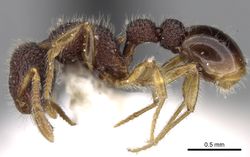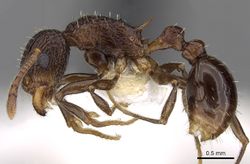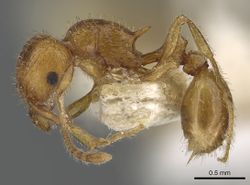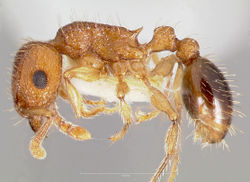Key to Tetramorium of India
This worker key is based on: Bharti, H. & Kumar, R. 2012. Taxonomic studies on genus Tetramorium Mayr (Hymenoptera, Formicidae) with report of two new species and three new records including a tramp species from India with a revised key. ZooKeys. 207:11-35. doi:10.3897/zookeys.207.3040
You may also be interested in
- Tetramorium of India
- Key Indian Tetramorium species groups
- Key to Indian Tetramorium inglebyi-group species
- Key to Indian Tetramorium tonganum-group species
- Key to the Indian and Sri Lankan Tetramorium tortuosum-group species
- Ants of India (species list)
- India Regional Project page
- Tetramorium
1
- The species with numerous branched hairs (bifid, trifid or quadrifid and in a few species a mixture of two or more of these may be present) . . . . . 2
- The species with only simple hairs . . . . . 9
2
return to couplet #1
- Antennae with 10 segments, propodeum unarmed . . . . . Tetramorium decamerum
- Antennae with 12 segments, propodeum with a pair of spines or teeth . . . . . 3
3
return to couplet #2
- Gaster cordate (heart) in shape . . . . . Tetramorium cordatum
- Gaster non cordate . . . . . 4
4
return to couplet #3
- Basal one-quarter to two-thirds of first gastral tergite distinctly sculptured with striation, puncturation or a combination of both; node of petiole in dorsal view strongly antero-posteriorly compressed, transverse, distinctly broader than long . . . . . Tetramorium walshi (in part - also #5)
- Basal portion of first gastral tergite not sculptured, the entire sclerite smooth and shiny; node of petiole variable in shape . . . . . 5
5
return to couplet #4
- Node of petiole in dorsal view strongly antero-posteriorly compressed, transverse, distinctly broader than long . . . . . Tetramorium walshi (in part - also #4)
- Node of petiole in dorsal view not antero-posteriorly compressed, not transverse, generally as long as broad or very slightly broader than long . . . . . 6
6
return to couplet #5
- Dorsal surface of hind tibiae viewed from in front or behind with abundant short, curved hairs of approximately uniform length which are much shorter than the maximum tibial width; these hairs characteristically forming a close mat above the tibial surface. Antennal scrobes vestigial, without an acute dorsal margin . . . . . Tetramorium rossi
- Dorsal surface of hind tibiae viewed from in front or behind with numerous long hairs of varying length, the longest of them at least subequal to the maximum tibial width; these hairs never forming a close mat above the tibial surface. Antennal scrobes developed with a marked dorsal margin . . . . . 7
7
return to couplet #6
- First gastral tergite with all hairs simple . . . . . Tetramorium coonoorense
- First gastral tergite with at least a few bifid or trifid hairs present . . . . . 8
8
return to couplet #7
- Mandibles smooth with scattered punctures, not longitudinally striate; HW 0.76–0.82mm; first gastral tergite with trifid hairs on basal half . . . . . Tetramorium obesum
- Mandibles longitudinally striate, the striation sometimes indistinct or absent in small specimens; HW 0.52–0.70 mm; first gastral tergite basally with a mixture of simple and bifid hairs, trifid hairs usually completely absent . . . . . Tetramorium lanuginosum
9
return to couplet #1
- Antennae with 11 segments . . . . . 10
- Antennae with 12 segments . . . . . 14
10
return to couplet #9
- Mandibles smooth with scattered pits, not striate. Small species, SL 0.42-0.46mm . . . . . Tetramorium smithi
- Mandibles longitudinally striate; usually this sculpture coarse and distinct but if faint then species much larger, SL 0.58mm . . . . . 11
11
return to couplet #10
- Propodeum armed with a pair of short triangular teeth which are only slightly longer than their basal width and only marginally longer than the propodeal lobes . . . . . Tetramorium urbanii
- Propodeum armed with a pair of long spines which are much longer than their basal width and considerably longer than the propodeal lobes . . . . . 12
12
return to couplet #11
- Postpetiole punctulate propodeal lobes rounded, not acute at apex . . . . . Tetramorium keralense
- Dorsum of postpetiole unsculptured, smooth and shiny, propodeal lobes triangular and acute . . . . . 13
13
return to couplet #12
- Dorsal mesosoma with rugulae tending to be effaced and replaced by shiny areas, HL 0.82–0.92mm, HW 0.78–0.86mm, SL 0.70–0.80mm, postpetiole unsculptured; entire body uniform dark brown or blackish brown . . . . . Tetramorium tortuosum
- Dorsal mesosoma reticulate rugose, HL 0.74–0.80mm, HW 0.66–0.70mm, SL 0.58–0.64mm, sides of postpetiole with rugulose sculpture; colour light brown with gaster darker than head and mesosoma . . . . . Tetramorium belgaense
14
return to couplet #9
- Species larger in size, body total length 5-6mm . . . . . Tetramorium beesoni
- Species total length less than 5mm . . . . . 15
15
return to couplet #14
- Posterior head margin emarginated . . . . . Tetramorium meghalayense
- Posterior head margin either emarginated or non emarginated . . . . . 16
16
return to couplet #15
- Lamelliform appendage of sting dentiform, triangular or pennant-shaped and projecting at an angle from the shaft, antennal scrobes either present or absent; frontal carinae either short or long . . . . . 17
- Lamelliform appendage of sting linear and spatulate, continuing the line of the shaft, antennal scrobes absent, frontal carinae short, ending before level of eyes . . . . . Tetramorium fergusoni
17
return to couplet #16
- Frontal carinae short terminating at or in front of the level of the eyes; dorsum of head variably sculptured . . . . . 18
- Frontal carinae long, projecting back beyond the level of the eyes. If the carinae fade out just behind the level of the eyes then the dorsum of the head is regularly, very densely longitudinally rugose or evenly sulcate . . . . . 22
18
return to couplet #17
- Eyes minute with only a single ommatidium. Peduncle of petiole with large anteroventral lamella . . . . . 19
- Eyes large with five or more ommatidia. Peduncle of petiole without a large anteroventral lamella . . . . . 20
19
return to couplet #18
- Anterior clypeus with distinct median impression, dorsal mesosoma reticulate-rugose and propodeal spines relatively long upcurved along their length . . . . . Tetramorium myops
- Anterior clypeus without any median impression, dorsal mesosoma longitudinally rugulose, and propodeal spines relatively short (PSL 0.07mm), triangular . . . . . Tetramorium triangulatum
20
return to couplet #18
- Head without any reticulate or rugoreticulate structure, petiole and postpetiole finely sculptured with a smooth median area or smooth median longitudinal strip on dorsum, propodeal spines not upcurved . . . . . Tetramorium caespitum
- Head with reticulate sculpture on its posterior region or sides, petiole and postpetiole mostly unsculptured, propodeal spines upcurved . . . . . 21
21
return to couplet #20
- Petiole node in dorsal view about as long as broad. Median portion of clypeus abruptly downcurved so that its anterior one-third is vertical and separated by a marked angle from the more posterior portion . . . . . Tetramorium inglebyi
- Petiole node in dorsal view much broader than long. Median portion of clypeus evenly convex in its anterior half . . . . . Tetramorium elisabethae
22
return to couplet #17
- Basal half or more of first gastral tergite sculptured, usually strongly so, with rugosity, dense striation, dense puncturation or a combination of these . . . . . 23
- Basal half of first gastral tergite unsculptured or at most with sparse, short, regular basigastral costulae or a few pits from which hairs arise . . . . . 24
23
return to couplet #22
- Anterolateral angles of first gastral tergite projecting forward as a pair of blunt teeth or tubercles; basal half of first gastral tergite and sternite strongly rugulose . . . . . Tetramorium rugigaster
- Anterolateral angles of first gastral tergite angular but not produced into teeth or tubercles, first gastral tergite and sternite entirely finely reticulate . . . . . Tetramorium malabarense
24
return to couplet #22
- With the gaster in dorsal view the lateral corners of the base extended forward as a pair of horns which surround the posterior portion of the postpetiole . . . . . 25
- With the gaster in dorsal view the lateral corners of the base rounded or sometimes bluntly angular, but never extended forward as a pair of horns which surround the posterior portion of the postpetiole . . . . . 26
25
return to couplet #24
- Anterolateral angles of first gastral tergite projecting forward as a pair of blunt teeth or horns which go round the sides of the posterior portion of the postpetiole; propodeal lobes elongate triangular and acute . . . . . Tetramorium mixtum
- Anterolateral angles of first gastral tergite projecting forward as a pair of acute teeth which go round the sides of the posterior portion of the postpetiole; propodeal lobes subtriangular with rounded tip . . . . . Tetramorium sentosum
26
return to couplet #24
- Anterior clypeal margin with the median portion convex and notched or sharply indented medially . . . . . 27
- Anterior clypeal margin with the median portion entire, varying from convex to broadly and shallowly concave, but never notched or sharply indented medially . . . . . 31
27
return to couplet #26
- Mandibles sculptured with fine, dense striation or shagreening, occasionally the striation faint . . . . . 28
- Mandibles completely smooth and shiny except for scattered hair-pits . . . . . 30
28
return to couplet #27
- Colour uniform dark brown to blackish brown. Petiole in profile with a narrow anterior peduncle, a short anterior face which curves into the long convex dorsum and a posterior face which is much higher than the anterior. In dorsal view the node is usually slightly longer than broad . . . . . Tetramorium pacificum (in part - also #30)
- Colour yellow brown to orange-brown, sometimes with the gaster darker brown. Rarely entirely coloured dark brown approaching that of pacificum, but in this case the petiole of different shape . . . . . 29
29
return to couplet #28
- Longest hairs projecting dorsally from frontal carinae behind the level of the antennal insertions shorter than the maximum diameter of the eye. Gaster always much darker in colour than alitrunk and head, contrasting strongly with them. Petiole node in profile roughly square, the dorsum not sloping upwards posteriorly, the anterodorsal and posterodorsal angles approximately on a level. Propodeal spines moderately long, varying from more or less straight to slightly upcurved along their length . . . . . Tetramorium bicarinatum
- Longest hairs projecting dorsally from frontal carinae behind the level of the antennal insertions longer than the maximum diameter of the eye. Gaster usually same colour as alitrunk and head, only rarely noticeably darker. Petiole node in profile with the dorsum sloping upwards posteriorly, so that the posterodorsal angles is on a slightly higher level than the anterodorsal. Propodeal spines usually short, elevated but more or less straight, not upcurved along their entire length . . . . . Tetramorium indicum
30
return to couplet #27
- Petiole in profile with a short anterior face which curves into the long convex dorsum and a posterior face which is slightly higher than the anterior, OI 25.81(eyes comparatively larger in size 0.24mm), CI 100, SI 67 . . . . . Tetramorium petiolatum
- Petiole in profile with a short anterior face which curves into the long convex dorsum and a posterior face which is much higher than the anterior, OI 20.59–25 (eyes comparatively smaller 0.18-0.21mm), CI 83-90, SI 79-87. . . . . Tetramorium pacificum (in part - also #28)
31
return to couplet #26
- Spaces between rugulose sculpture on entire dorsum of head (and often dorsal alitrunk) completely filled by a dense and very conspicuous reticulate-puncturation so that the surface appears dull, mat and very granular, the punctulate sculpture often as conspicuous as the rugulae . . . . . 32
- Spaces between rugulose sculpture on dorsum of head either smooth or with superficial faint or vestigial sculpture so that the surface appears mostly or entirely shiny and largely or partially smooth, the punctulate sculpture never as conspicuous as the rugulae . . . . . 33
32
return to couplet #31
- Frontal carinae strongly developed throughout their length, sinuate, running unbroken almost to the posterior head margin and surmounted throughout their length by a narrow raised rim or flange. The whole of the frontal carinae much more strongly developed than the remaining cephalic rugulae. Ground sculpture of head between frontal carinae strongly granular or reticulate-punctulate, the surface matt. Antennal scrobes shallow but broad and conspicuous . . . . . Tetramorium simillimum
- Frontal carinae feebly developed, weakly or not sinuate, most strongly developed to level of midlength of eye behind which they become very weak or broken, or gradually fade out posteriorly; not surmounted by a raised rim or flange beyond the level of the midlength of the eye, behind which the carinae are no stronger than the remaining cephalic rugulae. Ground sculpture of head more feeble than above, the surfaces dully shiny. Antennal scrobes vestigial . . . . . Tetramorium caldarium
33
return to couplet #31
- Dorsal surface of hind tibiae with decumbent or appressed pubescence only or with very short hairs which are curved through 90° at the base so that the apical portion of the hairs are nearly flush with the surface; erect or suberect hairs or erect pubescence completely absent from the outer tibial surface, SI ≥ 74 . . . . . 34
- Dorsal surface of hind tibiae with conspicuous suberect hairs, SI ≤ 67.00 . . . . . Tetramorium shivalikense
34
return to couplet #33
- Antennal scapes relatively longer, SI 87-91, colour uniform black . . . . . Tetramorium christiei
- Antennal scapes relatively shorter, SI 74-86, colour yellowish brown or dark brown . . . . . 35
35
return to couplet #34
- Peduncle of petiole in profile short and straight, not downcurved along its length from node to insertion nor passing through a rounded angle at about its midlength. Propodeal lobes bluntly rounded . . . . . Tetramorium salvatum
- Peduncle of petiole downcurved along its length. Propodeal lobes triangular . . . . . 36
36
return to couplet #35
- Propodeal spines short and about the size of triangular propodeal lobes, SI 74-79; EL 0.09mm and body dark brown with a reddish tinge . . . . . Tetramorium barryi
- Propodeal spines longer than the broadly triangular propodeal lobes, SI 80-87, EL 0.14–0.16mm, colour varying from yellowish brown to mid brown . . . . . Tetramorium salvatum

















































